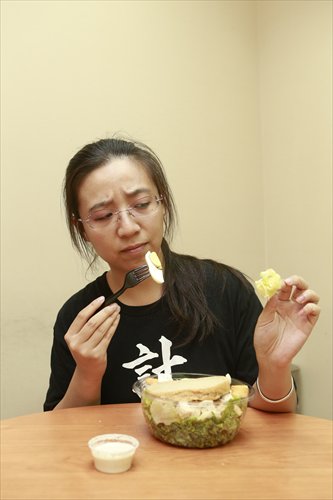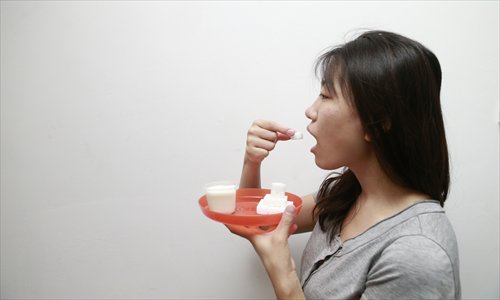Dietary deceptions
Some foods are not as ‘healthy’ as commonly believed

Nutritionists advise people optimize the nutritional value of their salads by using less leafy vegetables. Photo: Li Hao/GT
Li Fan, a 25-year-old IT worker in Beijing, has had salad for lunch for the past two months.
A meat-lover by nature, the motivation behind this switch to salads was a routine health check that revealed he was overweight and that his cholesterol and blood sugar levels were higher than what was healthy.
"Salad is a meal that many people looking to take care of their health tend to eat," he told Metropolitan, explaining his reasoning behind his choice.
To make a balanced meal which could provide both nutrients and energy, Li's salads started off with lettuce, cabbage, corn and other veggies as the base, with small amounts of chicken, bread or sausage as toppings. Caesar dressing soon became his favorite for its salty flavor and the fact it's not as creamy as mayonnaise or Thousand Island dressing.
Everything looked good, until his next health check when he found that he had neither lost any weight nor decreased his cholesterol or sugar levels. Actually, he was constantly plagued by a cold feeling in his stomach.
"I had diarrhea on several occasions, but my female coworkers who were also having salad called this 'detoxing,'" said Li, skeptically.
Like Li, many young people are having salad as a main meal, a trend which came to China from the West. However, while salad has become a symbolic icon of healthy food, nutritionists have found that salad is actually not as healthy as many believe.

Research shows homemade yogurt and salad dressing are healthier than similar processed products found in supermarkets. Photo: Li Hao/GT
What's in a salad?
According to a report by The Washington Post on August 23, US researchers Charles Benbrook and Donald Davis of The Organic Center in Oregon, developed a nutrient quality index that rates the nutritional value of food based on the content of 27 major nutrients per share (100 grams).
The four lowest-ranking vegetables on the index are often found in salads: cucumber, radish, iceberg lettuce and celery. According to the nutritionists, these ingredients are 95 to 97 percent water, while the amount of nutrients they provide are negligible.
"More people nowadays are favoring salad. Sales of these vegetables have almost more than doubled over the last year," said Kang Huayu, a waiter working at an Italian restaurant in Haidian district. According to Kang, the most popular salad in their restaurant is about 60 percent lettuce and 20 percent boiled chicken. Croutons, peanuts and other vegetables complete the salad.
"However, every time I clear the tables after our guests have left, I mostly find that the green leafy vegetables haven't been touched. Maybe because they're relatively bland compared with the other ingredients in the salad," said Kang.
According to Benbrook's research, lettuce is the most wasted vegetable in the US as more than 1 billion pounds of left-over salad goes uneaten every year.
Shi Jie, a nutritionist based in Beijing, points out this is partly due to salad vegetables' lack of nutrition and the imbalanced proportions of these vegetables: leafy vegetables make up more than half of most salads.
"Large green leaves are not the most effective appetite stimulant for people subconsciously making healthy food choices when eating," said Shi.
"People like to choose filling foods and avoid 'useless' ones."
Vegetables found in salad are also the chief culprit behind many food-borne illnesses. According to the US Centers for Disease Control and Prevention, green vegetables, including lettuce, cabbage and spinach, accounted for 22 percent of all food-borne illnesses from 1998 to 2008. This is because they are often eaten raw.
"We hate wasting food, so leftover leaves become a problem. We've found if we leave a bottle of salad dressing on the table, customers will put it on their salads and eat more," said Kang.
But Shi said that salad dressing is one of the hidden dangers in salads.
"The most common salad dressing has about 800 calories per 100 grams, and about 80 grams of that is fat."
Deceptively low
Actually, there are many foods like salad that are supposed to be healthy, but actually don't live up to the hype, such as coarse grain foods and low-fat and low-sugar foods.
Zhi Qianyue, a financial worker in Beijing, recently bought an oven with the intention of starting a bakery. However, when she began baking cookies last week, she discovered something surprising.
"I was thinking of baking cookies with coarse grains like oats or wheat sprout powder, which people say are healthier than regular flour," said Zhi.
"But when I was making them, I had to add more sugar and oil than grain powder to make dough, or else the mixture would just fall apart. "
Zhi then realized that so-called coarse grain foods in the market are high in oil and sugar. She then began paying more attention to the labels of coarse grain foods in the supermarket, and found that the fat content of these foods tend to fall between 25 and 30 percent.
"That's terrible! I always thought snacks made from coarse grains were healthy and non-fattening," said Zhi.
According to Shi, most coarse grain foods claim to contain a lot of dietary fiber, which is good for one's health.
"However the more dietary fiber a cookie contains, the worse it tastes, especially when dietary fiber reaches 5 percent. So when food labels say dietary fiber is 10 percent or higher, that really means oil, fat and sugar are the main ingredients."
What's more, Shi warns that since trans fats are good for making food soft and mellow, hydrogenated vegetable oil, maltodextrin (a polysaccharide used as a food additive) and non-dairy creamers are used to make coarse grain foods.
"Some drinks made from grains, such as corn and beans also contain a lot of sugar to make it taste better. Every 100 milliliters of these drinks contain about 10 grams of sugar, but less than 0.7 grams of dietary fiber."
According to a 2014 report from the Guangzhou Daily, many coarse grain drinks contain chemical additives including thickening agents and sweetening agents, and even sodium cyclamate, a sweetening agent banned by some countries since it may cause cancer or harm kidneys.
Low-fat and low-sugar foods are another marketing gimmick that can delude people pursuing good health.
According to a Daily Telegraph report in February, research by the University of the West of Scotland reveals that low-fat dairy products often contain higher amounts of sugar, increasing the risk of coronary heart disease.
Food claiming to be sugar free, said Shi, also has hidden dangers. For example, sugar-free dairy products, gum and many dim sum dishes, although they do not contain sucrose, do contain sweetening agents such as aspartame and acesulfame potassium, which can be just as unhealthy as sugar.
Cooking on your own
Shi thinks that the healthiest drinks and snacks are those that are natural and have undergone less processing.
She suggested that homemade food is the best and easiest path to good health.
For a really healthy salad, Shi suggests people who make it on their own use less leafy green vegetables and include more nutritious vegetables such as collard greens and arugula to replace lettuce and cabbage.
She also suggests adding fish instead of chicken or beef, and replacing shop-bought salad dressing with homemade dressing made from eggs, olive oil, white vinegar, sugar and salt.
"You can control the amount of sugar and salt this way, which is definitely healthier than shop-bought dressing," said Shi.
"And you have to wash every leaf carefully before eating, to lower the risk of diseases caused by residual pesticides and harmful bacteria."
As for choosing coarse grain snacks and drinks, Shi said that consumers should learn to read nutrition labels and avoid buying food with more than 10 percent fat, especially trans fats. Homemade coarse grain foods are a better choice since people can ensure no additives have been added.
If people want to make yogurt at home, Shi explained that they can use fresh milk and put in much less sugar.
"You can make use of natural sugars by adding fruit to the mix. If you want to make the yogurt more healthy with more unsaturated fatty acid, you can add some olive oil or almond powder," said Shi.